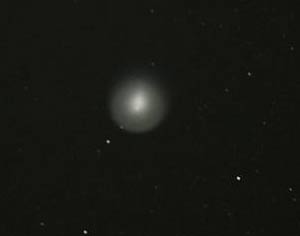A comet is visible with the naked eye
A comet suddenly shines in the past few weeks and is now visible to the naked eye, drawing attention from not only professionals but also amateur observers.
Paul Lewis, Dean of the Department of Astronomy at Tennesssee University (USA), led the school's students to the roof of a building to see for himself this 17P / Holmes comet. 17P / Holmes exploded and its head, a cloud of gas and dust illuminated by the sun is growing, exceeding the size of Jupiter.
A comet without a tail is usually similar to other celestial bodies, but the tail of comet 17P / Holmes is visible from the north, in the constellation Perseus, with dim spots like stars in the constellation Bear (Big Dipper). )."This is truly a surprise in astronomy," Mr. Lewis said.

Comet 17P / Holmes is seen among the stars in the constellation Perseus.(Photo: AP)
Since October 23, astronomers have been able to observe this comet with a telescope but on that night, it suddenly burst and expanded. In 1892, a similar comet explosion was discovered by Edwin Holmes.
"It can be said that this is a life event only once seen, just like when Shoemaker comet Levy 9 hit Jupiter in 1994," Mr. Lewis said.
Scientists surmised, comet 17P / Holmes exploded because it had many holes in its mind, a honeycomb-like structure. The explosion caused ice from comets to be released in the sun, turning into gas.
It is impossible to predict what will happen when comets approach the sun, Mr. Lewis said. We were waiting to see the head of the comet cloud and its tail, but it looked more like an explosion and we were watching the gas bubbles and dust coming from the center of the explosion.
Experts predict that observing comet 17P / Holmes can continue for at least another week if not monthly. If you use a telescope or binoculars, you can see more clearly.
- The ISON comet can be observed with the naked eye
- The brightest blue comet in the sky rushes towards Earth
- Video: Comet hit the sun
- Century comets
- Century comet directs the sun
- Astronomers love to see the new phenomenon of 15 years of excitement
- Comet detection is the brightest century
- Comet is brighter than the full moon visiting Earth in 2013
- Research: Sleeping naked makes you happier
- Comet ISON only has dust left
- The comet of the century will not light
- Comet Lovejoy comet image from all over the world
 Van Allen's belt and evidence that the Apollo 11 mission to the Moon was myth
Van Allen's belt and evidence that the Apollo 11 mission to the Moon was myth The levels of civilization in the universe (Kardashev scale)
The levels of civilization in the universe (Kardashev scale) Today Mars, the sun and the Earth are aligned
Today Mars, the sun and the Earth are aligned The Amazon owner announced a secret plan to build a space base for thousands of people
The Amazon owner announced a secret plan to build a space base for thousands of people